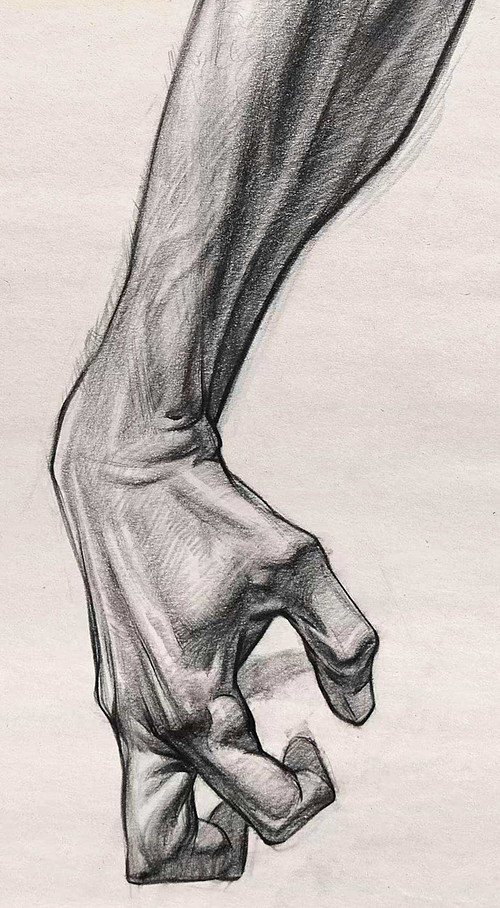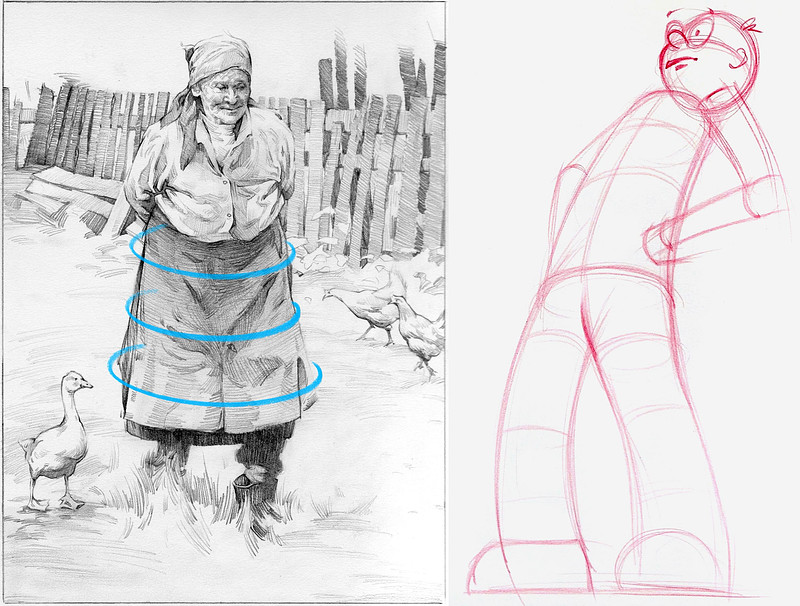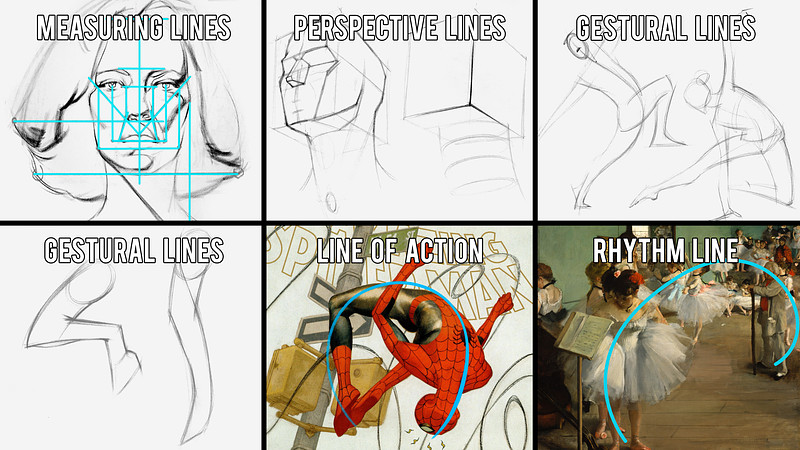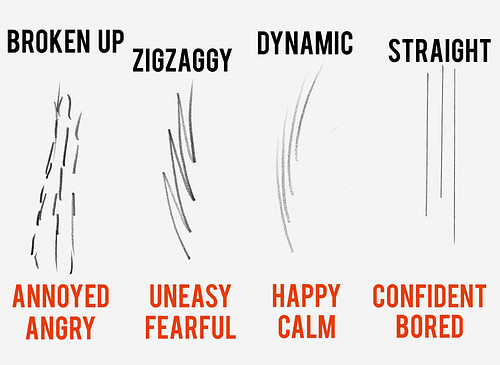So, you might be thinking that.. a line is just a line. Right? NO! IT’S NOT JUST A LINE. IT IS SO MUCH MORE THAN THAT!
When drawing in black and white, every line you draw has a shape, value (how light or dark the shape is), and edge (the transitions of the borders).
The shape of a line can be thin, thick, or anything in between.
The edge can be sharp, firm, or soft.
The value can be anywhere in the range from light to dark.
And you’re supposed to control all that while you’re putting that mark down? Yaa. And there’s actually more to it! Don’t forget that a line can transition from one type to another. The shape can go from thin to thick. The edge can be sharp on top and soft on the bottom. Or start suddenly and taper out softly on the other end. The value can start light and go to dark and then back to light again. And that’s why drawing is hard. And that’s what we’re gonna learn how to do in the next several lessons and projects in my drawing basics course!
The good news is that you’re never going to be thinking of all that information when you put each line down. That’s impossible! You’re only human! Good line quality is when you have combinations of all these elements that look good. And there are so many combinations that look good. It’s not like there’s just one right answer in each case. Eventually, you won’t even be thinking about your lines. You will have the muscle memory for good line control and you’ll just be thinking about the qualities of the subject that you’re drawing.
Cause that’s really what lines are for. Well actually, let’s explore that. Let’s explore the different ways we use lines.
Different Ways We Use Lines
Symbolic lines make up icons, symbols, letters, or numbers that we use on an everyday basis, like the alphabet! Words do have their place in visual art. For example in comics, dialog or sound effects are represented with words. They can be clean and legible, or highly stylized.
Artists use contour lines to outline the shape of something. The further back you go in history the more artists used primarily outlines and symbols in their art. We tend to gravitate to using contour lines to draw something.
As kids, we naturally start drawing contours. When we touch things, we can feel the edges, and our mind thinks of them as lines, even though that’s not what we actually see. Even if we’re drawing more tonally, contour lines can still be very beneficial to emphasize or clarify something.
When we place many lines together closely, we create shading lines that indicate value or even a texture or atmosphere or motion.
Similarly, cross-contour lines can indicate tone, but they specifically wrap around the form like a rubber band to express the form even more clearly. Sometimes a cross contour line doesn’t have a tonal purpose, but rather is used early in a drawing to quickly indicate volume. In that case it’s a construction line.
Construction lines (aka layin lines or guide lines): Category of lines for various purposes in the early stages of a drawing.
- We can use measuring lines to establish proportions and placement with angles.
- Show depth and form with perspective lines, such as the cross-contours or XYZ axis lines when something is simplified down to a box.
- We can also use gesture lines to represent a pose or the motion of something, like an arm. It can be compressed with tension, or relaxed and flowy. When you see someone do a loose sketch, it’s usually very heavy on gesture lines, but not exclusively. A line of action is a gestural line that tries to capture the flow of a pose with a single line.
- Rhythm lines are very similar but are used to find connections between things to guide the eye and show flow in a composition. I can find a rhythm that connects all the knuckles in a hand, but that’s not the gesture of the hand.
Line’s are pretty freakin’ useful… We’re going to start learning and practicing contour and construction lines pretty soon in this course actually. And the shading lines will come later when we get into values and edges.
Lines represent Ideas
When drawing a line remember that you're not just drawing a line. You're communicating what the line represents - an idea. Simple ideas are combined to complex ideas, which are combined further to tell stories. Letters to words to sentences to novels. Lines are like letters. Which is funny cause letters are made up of lines…
Anyway, here’s an example.
A circle can represent the cranium of the head. That's a simple idea. Add some construction lines and you have a more complex idea - a head in space. Add shading lines to it and the idea becomes even more complex - a specific person with specific lighting.
Lines don't just represent ideas about objects in space. They can even convey emotions!
Line and Emotion
As your artistic skills develop, gradually let go of the desire to simply replicate reality, and instead try to communicate the emotions and ideas you want to express. Lines, whether we mean to or not, carry emotional qualities.
The thing is, emotions are very complicated and often individual to each person. Two people can have different emotional reactions to the same drawing. So, it’s not an exact science. It’s not like I can show you a line and say “well THIS, this is a happy line. And this is a disgusted line.” But lines can definitely add to the emotional impact of a piece. If your drawing is supposed to induce fear and anxiety you might want to use lines that match that goal. Confident beautiful tapering lines might not fit here. But shaky uncertain lines that were drawn by someone who is anxious and fearful might help. I keep saying ‘might’ because those same wobbly lines can be used to have a comedic or childish effect. Lines are just one tool that contributes to the larger story of the work.
To get a better understanding of the emotional qualities of lines, it can be helpful to look at the work of different artists.
- Heinrich Kley
- Bernie Wrightson
- Glen Keane
- Tim Burton
- Claire Wendling
- Egon Schiele
- Aaron Blaise
- Eliza Ivanova
- Kim Jung Gi
- Charles Schulz
- George Herriman
- Bill Watterson
- Charles Gibson
- James Montgomery Flagg
- Karl Kopinski
- and of course my instructor, Jeff Watts.
These are all great examples of how lines can convey different emotions. And there are hundreds, thousands more that I didn't mention. If you’re yelling at the screen, go ahead, and leave a comment of your favorites and we can get a more exhaustive list.
If you’re interested in exploring the emotional impact of lines, here’s one thing you can do. Look at various types of lines and describe them with objective words. What do these lines look like? Broken up, zig-zaggy, dynamic, straight. Then see how these words make you feel. Annoyed, angry? Uneasy, fearful? Happy, calm? Confident, bored? You might have said some different words than I did here. And viewers of your work might have different interpretations of your work. That’s fine!
In this course, I'm not going to teach you style. That’s something you’ll develop on your own as you grow and mature as an artist. Artists have very different line qualities depending on their styles, and there is no right or wrong style. Some artists are more exact and precise with their lines while others are more expressive, loose, and sketchy. Some artists are deliberate with what their lines might say, while others kinda just go with the flow and draw what they think looks good.
Conclusion
So, lines are basically shapes with values and edges. We usually start our drawings with lines. They’re quick placeholders for more complex ideas. There are several ways we use lines to represent different things such as shapes, shadows, measurements, gesture, perspective and even words and emojis. They can add emotion and guide the viewer’s eyes to parts of the drawing. Even if the end result of your drawing doesn’t have any lines in it, lines can help you get there.
Lines are important. So let’s start practicing them!
Join the premium course for additional and extended lessons, full lesson notes, assignment demonstrations, and more!





































